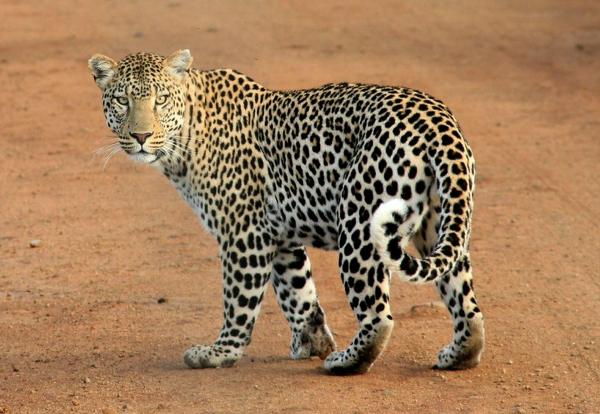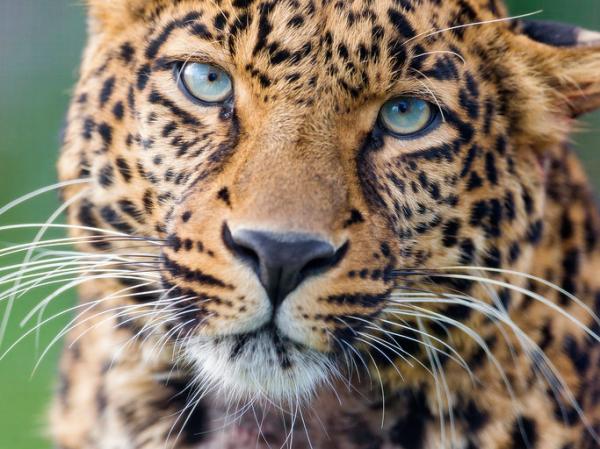
Leopards are mammals that belong to the family Felidae and the species Panthera pardus. Eight subspecies of leopard have been identified and are distributed over a large geographic area. Once common throughout most of sub-Saharan Africa, the leopard inhabited parts of northern and northeastern Africa and ranged from Asia Minor through Central Asia and India to China and Manchuria. However, their distribution has declined significantly over the years.
In the following AnimalWised article, we explain where leopards live according to subspecies.
Distribution of the leopard
The leopard is one of the most adaptable big cats. It inhabits all types of habitats as long as it has a place to hide and there is enough prey to survive. It can be found in forests and jungles, savannahs, fields and rocky places, and even deserts.
Being the most adaptable big cat, the leopard is also the most widespread big cat in the world. However, factors such as the loss and fragmentation of its natural habitat and poaching for trade in its fur or body parts for purported medicinal purposes are the greatest threats facing most leopard subspecies today.
This situation has led to a drastic decline in the number of leopards in recent years. In most of the cases described below, leopard populations are isolated, which hinders their growth as a species. Here you can see how the different leopard species are currently distributed:
Distribution of the African leopard (Panthera pardus pardus)
The African leopard was one of the most widespread subspecies. It is found throughout the African continent, from mountain forests to grasslands and savannas, except for the extremely sandy desert. However, due to direct hunting by humans, its presence has declined significantly in recent decades.
In North Africa, for example, there are only a few isolated populations of the African leopard left, living in the Atlas Mountains of Morocco. In West Africa, their occurrence has been reported with temporal fluctuations in regions such as Niger, Senegal, Nigeria, Sierra Leone, on the eastern border with Guinea and Liberia, and in Ghana and Benin.
Finally, in the south of the African region, where there appear to be more stable populations, they are found in Angola, Zambia, Zimbabwe, Mozambique, Namibia, Botswana, and the Cape provinces of South Africa.
Distribution of the Arabian leopard (Panthera pardus nimr)
This species of leopard lives in the Dhofar region, more specifically in Oman and also in the northeast of Yemen, which is its main distribution area. To a lesser extent and probably extirpated in some areas, it is also found in Saudi Arabia, Israel, and the Negev Highlands. Similarly, there are some isolated populations in the United Arab Emirates and in Egypt.
Distribution of the Panthera pardus tulliana
This subspecies is common in regions such as Turkey, the Caucasus, and part of the Asian part of Russia. It also occurs in the area known as the Persian Plateau and Hindu Kush.

Distribution of the Indian leopard (Panthera pardus fusca)
The range of the Indian leopard includes areas such as India, Bhutan, Nepal, Pakistan, the Himalayan forests, Bangladesh and Tibet.
Distribution of the Sri Lankan leopard (Panthera pardus kotiya)
This subspecies inhabits mainly the island area of Sri Lanka, where it used to have a wide distribution, but is now highly fragmented due to human interference.
Distribution of the Indochinese leopard (Panthera pardus delacouri)
This subspecies inhabits several Asian countries, including Cambodia, China, Lao People's Republic, Malaysia, Myanmar, Singapore, Thailand, and Vietnam. As in the previous cases, the leopard is probably largely extirpated in some of these regions, and only a few isolated populations remain.
Distribution of the Javan leopard (Panthera pardus melas)
The Java leopard is a subspecies restricted to the Indonesian island of Java. The population is estimated at 188-571 sexually mature individuals in 22 fragmented subpopulations and shows a declining trend.
Distribution of the Amur leopard (Panthera pardus orientalis)
This subspecies has also been severely affected by human intervention and is therefore threatened with extinction. Therefore, its distribution is very limited. It currently inhabits some regions such as eastern Russia, northern China and Korea.
Habitat of the leopard
Leopards are distributed across a wide range of habitats. In fact, as mentioned earlier, the leopard is the most adaptable and widespread big cat in the world.
Historically, their range was quite large. By 1750, the leopard's range extended across almost all of sub-Saharan Africa, took in parts of northern and northeastern Africa, and stretched from Asia Minor through Central Asia and India to China and Manchuria. By 2019, the species had lost up to 75 percent of its former range. Habitat fragmentation, a reduced prey base, and human-wildlife conflict have severely reduced the population of this species in most parts of its range. Leopards can still be found in the following habitats:
- Desert regions
- Semi-desert regions
- Mountainous regions
- Savannah grasslands
- Scrublands
- Tropical rainforests
- Forests
- Snowy regions
Leopards are generally asocial animals that live reclusive lives and avoid other leopards. However, leopard habitats usually overlap, and it is not uncommon for a male leopard's habitat to often overlap the territories of several females. Females live with their young in territories that largely overlap and continue to have contact with their offspring after weaning.
If you want to learn more about leopards, do not miss this other article where we talk about each subspecies and their main characteristics.

Protected areas for leopards
After learning about the distribution of the leopard and where it occurs today, let us explore its protected areas.
Many leopard populations have evolved in protected areas, but many others have not, which contributes to their plight. In some cases, they also live near populated areas, which undoubtedly leads to conflict as they hunt for domestic animals. As for protected areas, this also depends on the country or region where the subspecies is native. Below are some examples of protected areas where leopards live:
Protected areas in Africa
Here you can find the protected areas where leopards live on the African continent:
- Virunga National Park (Democratic Republic of the Congo)
- Niokolo-Koba National Park (Senegal)
- Outamba Kilimi National Park (Republic of Guinea)
- Gola National Forest (Sierra Leone)
- Lofa-Mano National Park (Republic of Liberia)
- Mole National Park (Ghana)
Protected areas in Asia
Here you can find the protected areas where leopards live on the Asian continent:
- Golestan National Park (Iran)
- Ayubia National Park (Pakistan)
- Machiara National Park (Pakistan)
- Pir Lasora National Park (Pakistan)
- Kanchenjunga Conservation Area (Nepal)
- Mount Halimun Salak National Park (Indonesia)
- Ujung Kulon National Park (Indonesia)
- Mount Gede Pangrango National Park (Indonesia)
- Mount Ciremai National Park (Indonesia)
- Mount Merbabu National Park (Indonesia)
- Gunung Merapi National Park (Indonesia)
- Bromo Tengger Semeru National Park (Indonesia)
- Meru Betiri National Park (Indonesia)
- Baluran National Park (Indonesia)
- Alas Purwo National Park (Indonesia)
- Badkhyz Nature Reserve (Turkmenistan)
- Hunchun National Nature Reserve (China)
If you want to learn more about other animals that are currently threatened with extinction, continue reading this other article where we talk about 10 animals that are threatened with extinction.
If you want to read similar articles to Where Do Leopards Live?, we recommend you visit our Facts about the animal kingdom category.
- Hunt, A. (2011). Panthera pardus. Animal Diversity Web. Available: https://animaldiversity.org/accounts/Panthera_pardus/
- Kittle, A.; Watson, A.C. (2020). Panthera pardus ssp. kotiya . The IUCN Red List of Threatened Species. Available at: https://dx.doi.org/10.2305/IUCN.UK.2020-2.RLTS.T15959A50660847.en. A
- Face-Garcia, S.; Kamler, JF; Clements, G.R.; Lynam, AJ; Naing, H. (2019). Panthera pardus ssp. delacouri (errata version published in 2020). The IUCN Red List of Threatened Species. Available at: https://dx.doi.org/10.2305/IUCN.UK.2019-3.RLTS.T124159083A163986056.en
- Stein, AB; Athreya, V.; Gerngross, P.; Balme, G.; Henschel, P.; Karanth, U.; Miquelle, D.; Face-Garcia, S.; Kamler, JF; Laguardia, A.; Khorozyan, I.; Ghoddousi, A. (2020). Panthera pardus (amended version of 2019 assessment). The IUCN Red List of Threatened Species. Available at: https://dx.doi.org/10.2305/IUCN.UK.2020-1.RLTS.T15954A163991139.en
- Wibisono, H.; Willianto, E.; Pinondang, I.; Rahman, DA; Chandradewi, D. (2021). Panthera pardus ssp. melas . The IUCN Red List of Threatened Species. Available at: https://dx.doi.org/10.2305/IUCN.UK.2021-2.RLTS.T15962A50660931.en